Latua
Latua pubiflora (Griseb.) Baillon, (common name in Spanish: árbol de los brujos, tree of the sorcerers) is the single species of the monotypic genus Latua Phil., endemic to the coastal mountains of southern Chile. A shrub or small tree to 10 m in height, bearing attractive, magenta-to-red, hummingbird-pollinated flowers, it is extremely poisonous – hallucinogenic (deliriant) in smaller doses – due to tropane alkaloid content and is used by Chilean machi (shamans) of the Mapuche–Huilliche people in traditional medicine, as a poison and to enter trance states. Its elegant flowers and yellow tomato-like fruit are attractive enough to merit its cultivation as an ornamental (with due care regarding toxicity).[2][3][4]
| Latua | |
|---|---|
_Baillon_single_flower.jpg) | |
| Scientific classification | |
| Kingdom: | |
| (unranked): | |
| (unranked): | |
| (unranked): | |
| Order: | |
| Family: | |
| Subfamily: | |
| Genus: | Latua |
| Species: | L. pubiflora |
| Binomial name | |
| Latua pubiflora | |
| Synonyms[1] | |
|
Latua venenosa Phil. | |
Taxonomy
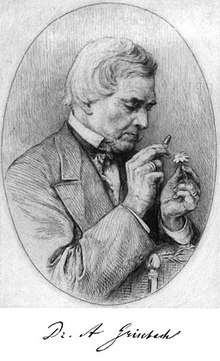

_CIPN21501.jpg)
The plant first entered the scientific record in the mid 19th century with the publication of the Linnaean binomial Lycioplesium pubiflorum by German botanist and phytogeographer August Heinrich Rudolf Grisebach in 1854.[5] Grisebach described the plant (under the name Lycioplesium pubiflorum) from a specimen collected by Lechler near the city of Ancud on the north coast of Chiloé Island.
The genus name Latua was published by German-Chilean naturalist Rodolfo Amando Philippi Krumwiede in the journal Botanisches Zeitung No. 33, August 1858: Latua Ph., eine neues Genus der Solanaceen (pp. 241–242), as the generic element in the binomial Latua venenosa.
The current binomial, Latua pubiflora, juxtaposing Grisebach's specific name and Philippi's genus name was published by French botanist and physician Henri Ernest Baillon in Histoire des Plantes vol. 9, published in Paris in 1888 by Librairie Hachette - page 334.[6]
Scientific name
The genus name Latua was created by Philippi by Latinising the indigenous Mapudungun (Mapuche / Araucanian) name for the plant, which exists in a number of local variants, the oldest of which is the (now obsolete) Latue-hue. This is derived from the Mapuche verb Lan 'to die', tu, a causative particle, and hue 'the instrument with which something is done', giving the meaning 'that which causes (something) to die' i.e. 'lethal' or 'deadly'.[7][8][9] Three more modern forms of the same derivation are the regional variants latúe, latué and latuy.[6] [Interestingly, the last of these can also designate the (unrelated) hallucinogenic plant Desfontainia spinosa, which, although psychoactive, has not been recorded in the literature as being dangerously toxic].[10] The Latin specific epithet pubiflora means simply 'having hairy flowers'. The binomial Latua pubiflora in its entirety may thus be translated as the deadly poisonous plant with hairy flowers.[6]
Vernacular names in Spanish
The vernacular name for the plant in Spanish most frequently encountered in the literature is árbol de los brujos, meaning 'tree of the sorcerers', in reference to the use of the plant by the Chilean machi. This reflects the fact that, while the machi of today are usually female, historically this important rôle as practitioner of the sacred was often filled by transvestite or homosexual men, or intersex individuals.[11][12] The inference is that in a Mapuche culture less affected by European conceptions of gender and the sacred, an ambiguous or non-binary status was actually one of the signs or markers of sacred status. By contrast, in an ironic twist, gender-fluid individuals in the Mapuche culture of today can fall victim to discrimination.[13]
Other vernacular names recorded include palo de bruja – 'witch tree' and palo mato – 'tree (stick) that kills', the latter being identical in sense to the Mapudungun word latué (see above).[6]
Description
Woody, spiny, evergreen, heteroblastic plant 2–10 m in height with one (tree) to several (shrub) trunks 3–25 cm in diameter, trunks spreading upward and outward from base; bark thin, grey-green, streaked with corky, longitudinal fissures, becoming reticulate and somewhat rough, reddish to greyish brown / buff; branches smooth, grey-green and armed with spines; branchlets cylindrical, those of current year's growth covered with yellowish-brown pubescence, glabrescent; spines rigid, erect, arising as modified branches in leaf axils, up to 2 cm in length, usually with small leaf at base and one or two minute cataphylls toward the apex; leaf blades 3–12 cm in length by 1.5–4 cm in width, finely hairy, petioles circa 2 mm long. Flowers pendent, borne in late Winter / early Spring. pedicels tomentose, 5–20 mm long; calyx 8–10 mm long, densely pubescent ; corolla urceolate (urn-shaped), magenta to red, 3–4 cm in length and circa 1.5 cm at the middle, with a densely pubescent exterior; style magenta, bearing bright green, capitate stigma; filaments of stamens magenta, attached at base of corolla for circa 8 mm and hairy at their bases, anthers purple, somewhat heart-shaped and circa 2 mm in length, dehiscing to reveal ash-grey pollen. Fruit a globose berry, a little flattened in shape and of a yellow to orange-yellow colour, circa 2 cm in diameter, seated in a densely hairy, accrescent calyx 11–16 mm in length, the lobes spreading and the calyx often splitting when the berry is fully ripe. Seeds thick, slightly longer than broad, circa 2 mm long, dark brown to black.[2][6]
Flower colour

As Plowman notes, there has been a measure of controversy concerning the colour range displayed by the flowers of Latua pubiflora.[14][15] The label on the type specimen bears the Latin description flores coccinei i.e. 'flowers deep red', whereas subsequent authors have referred to them as variously 'violet',[16] 'red'[17] and atro-violaceus (dark violet)[15] on the chromotaxy scale devised by Pier Andrea Saccardo. However, after observing flowers gathered from Latua plants growing in several different localities, Plowman expressed the opinion that, while there is some variation in flower colour, the flowers are usually magenta (as defined in Horticultural Color Chart 27/1).[6]
Distribution
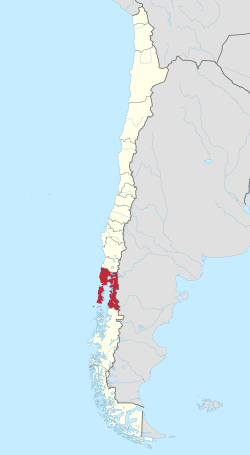

.jpg)
.jpg)
.jpg)
...the plant grows only in the narrow coastal cordillera between Valdivia and Chiloé, a difficult mountainous terrain with an extremely wet climate and few roads; during the rainy season, the existing roads are nearly impassable.[6]
– thus Plowman, writing in 1971, adding, on page 66:
Latua pubiflora is found sporadically in the coastal mountains of southern Chile between 40 degrees and 43 degrees latitude from the province of Valdivia to Chiloé. This region has...over 2540 mm (100 in.) of rainfall annually. Latua occurs primarily in the middle elevations of the cordillera between 300 and 900 m (900 and 2700 ft.).[6]
The range of distribution of the species thus corresponds roughly to the Los Lagos Region ( Lakes Region ), the plant occurring in all four of its component provinces: Chiloé, Valdivia, Osorno and Llanquihue. The Los Lagos Region is the only area within Chile classified as having predominantly Köppen climate type Cfb (Oceanic climate) according to the Köppen climate classification. The indigenous Huilliche people, whose shamans possess much esoteric knowledge concerning Latua ( and, indeed, their entire indigenous flora ), call this land to which they and their plant are native Futahuillimapu - 'great land of the south'.[18]
Habitat
An element originally of the Valdivian temperate rainforest, Latua is to be found increasingly in areas occupied by fields and pastures as a result of extensive deforestation undertaken to produce timber and devote land to grazing. Despite this habitat loss, the species had (at the time of Plowman's writing) adapted well to the more open conditions prevailing on cultivated land - so much so that, although known from relatively few localities, it had actually become something of a weed of roadsides and open places in those localities where it was present, thanks to its propensity for suckering, spreading easily by adventitious branches from its underground parts - despite efforts to eradicate it by removing top-growth. Latua grows usually as a tall shrub along clearings and in secondary forests and can, in shaded woodland, attain its maximum recorded height of 10m. It is frequently to be found growing in association with species belonging to the genera Eucryphia (e.g. E. cordifolia and E. glutinosa), Laurelia (i.e. the single Chilean species L. sempervirens) and Chusquea (a genus of New World bamboos).[6]
Flowering season
In the northern part of its range, in the provinces of Osorno and Valdivia, Latua pubiflora is Autumn-flowering and Spring-fruiting, the flowers starting to appear in October at the beginning of the rainy season and the fruits being borne in February and March. By contrast, in the southern part of its range - where there is less seasonal variation in precipitation - the plant flowers in Spring or Summer: in Llanquihue, Latua bears flowers in March, while in Chiloé they are borne in July. Plowman further notes that, under favourable conditions, the plant may flower more than once a year, but that he and his colleagues had not observed this personally.[6]
In cultivation in the U.K., Latua is Spring-flowering, blooming in March and April (as in the wild in the province of Llanquihue).[19]
Toxicity
The marked toxicity of Latua was noted frequently in the early literature on the plant.[16][20][21][22]
Symptoms of poisoning
Unsurprisingly for a tropane-rich Solanaceous plant, the effects produced by consumption of Latua pubiflora closely resemble those of intoxication by its infamous Old World cousin Deadly Nightshade: a dry mouth, a hot and feverish feeling in the body, eyes with greatly dilated pupils and blurred vision, frothing at the mouth ( from thickening of saliva ),[23] acute mental disturbances and 'insanity', convulsions, delirium and hallucinations.[6]
The cerebral effects have been characterised as
intense psychomotor agitation accompanied by delirium which corresponds to acute, exogenous, toxic psychosis.[24]
Folk medicinal antidotes
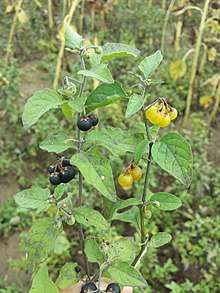
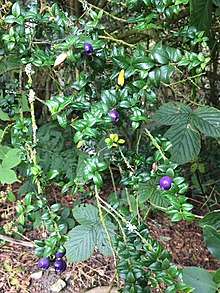
.jpg)
...los hechiceros [= Machi / sorcerers ] could quickly recover [ from Latua intoxication ] with a drug from a Solanum species of the section Morella ( to which Solanum nigrum belongs).[25]
The above quotation from a letter sent by Dr. Benkt Sparre to Plowman enlarges upon the testimony of Murillo[16] and Mariani,[24] according to whom the most frequently mentioned antidote to Latua poisoning is Solanum nigrum L., ( known in Chile by the vernacular Spanish name hierba mora ): "...a decoction of mora is drunk for eight days while fasting. Compresses soaked in the infusion are wrapped about the head or neck or rubbed on the back". [ Note: in the absence of a voucher specimen, Dr. Sparre considered the identification of the species involved to be tentative i.e. a plant 'like' hierba mora / 'probably' a Solanum species ].
Similarly used are a species of Oxalis known locally as culle and the fruit of the shrub Rhaphithamnus spinosus ( family Verbenaceae ) - see page Rhaphithamnus - known locally as espino negro ( = 'black thorn' ).[6]
A prominent after-effect of poisoning by Latua, as first noted by Philippi in 1861, is persistent severe headaches.[26]
The self-experimentation of Dr. Sparre
Few outsiders to the Los Lagos Region have experienced the effects of Latua at first hand, making Dr. Benkt Sparre's account [25] of his self-experimentation with an infusion of Latua of particular interest. Dr. Sparre, later Curator at the Museum of Natural History of Stockholm, was, at the time of his self-experiment, Professor at the Universidad de Concepción de Chile and was living in an agricultural college in Centinela. On the evening of January 1, 1954, just before attending what he describes as a fête-champêtre, Sparre drank approximately 5cl of an infusion prepared ( apparently by himself and in the manner described by his informants ) from the green leaves and bark of Latua. The initial effects were slow to appear: after about 3 hours he noticed an extreme dryness of the mouth accompanied by a strong desire to spit, with spitting made difficult by the drying of his saliva to a froth at first whitish and later more solid ( viscous ). There was also a strong desire to urinate ( with urination itself almost impossible ). A little later, he experienced a "heavy" intoxication unlike (- and not as pleasureable as - ) alcoholic intoxication, manifesting as 'an immediate and almost complete loss of memory '. Sparre attended the party ( where he seems to have made an unsuccessful pass at a local girl ) in his bufuddled condition and was later put to bed by a friend, without having any memory of the fact. Later that night he awoke with a feeling of claustrophobia and injured himself slightly, while blundering about in a very confused state in search of the toilet, having finally to be physically restrained and locked in his room by the same friend. The following morning Sparre awoke with a strong hangover but still determined to take part in a previously-planned excursion, and believing himself to be "fairly clear in the head" - which was soon proved to be very far from the case:
I suddenly spoke to those present in a completely unknown language without looking at anyone present. Unfortunately, I remember nothing from this conversation, nor with whom I thought I spoke...What I remember is that I suddenly jumped out of my chair, thinking that somebody wanted to beat me. It was my own hand which [ had ] hung on the back of my chair which [ had ] frightened me. [25] [Compare disorder Somatoparaphrenia].
During the day-long excursion Sparre's consciousness alternated between periods of clarity and periods of drowsy, quasi-hallucination:
During these latter periods, I saw the forest around the road as some kind of Russian boyar-ballet in heavy costumes.[25]
Sparre had returned to normal by the evening of January the 4th when he regained the ability to read, which had deserted him during the experience [explicable partly by blurred vision due to mydriasis]. He noted, however, that when he wrote up his journal that evening he had difficulty in keeping to the lines.[25] [ Note: comparison of Dr. Sparre's experience with the dramatic (not to say lurid) generalised accounts of Latua poisoning of other authors referenced in Plowman's paper, suggest that the amount of alkaloids he consumed in his 5cl of Latua infusion may have been relatively small: he experiences, in general, drowsy confusion rather than raving mania, although the long duration of his "trip" and its after-effects ( several days ) and its associated patchy amnesia are thoroughly in keeping with experiences produced by tropane alkaloid-containing Solanaceae ].
Latúe and Tayu : a potentially lethal confusion
_with_that_of_Dasyphyllum_diacanthoides_(_right_)%2C_showing_ease_of_confusion.jpg)
A major cause of accidental poisoning by Latua is its unfortunate similarity (when not in flower) to the Tayu tree Dasyphyllum diacanthoides ( family Asteraceae ), the bark of which is a source of popular remedies ( both topical and oral ) for blunt trauma.[6] The dangers of mistaking Latua for Dasyphyllum are first mentioned by Philippi in his original 1861 account of Latua:
One of his [ Philippi's informant Señor Juan Renous's ] woodcutters had suffered a strong blow with the blunt end of his axe and went into the forest to get some bark of tayu for it. He took instead Latúe [ Latua ] and drank a concoction of this poison. He became insane almost immediately and wandered into the mountains. He was found three days later in an unconscious state. Several days were required for his recovery, although he suffered severe headaches for several months.[26]
Fish poison
Latua was used by the Huilliche as a fish poison as late as the early years of the twentieth century: the juice of the plant (plant part unspecified, but probably that of sappy, green branches) was placed into slow-flowing rivers, causing the fish in them to become torpid and easily caught.[27] Plowman's indirect quotation of Pomar's reference to this practice mentions also Drimys winteri, another tree species considered sacred by the Huilliche, but it is not clear from the context whether the juices of Latua and Drimys were used separately or in combination as ichthyotoxic agents.
Magic tree of the Huilliche shamans: Latua and the Machi
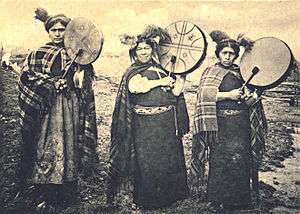
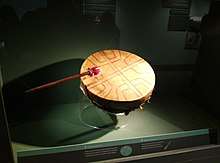

Philippi wrote in 1861
It has been six years now since I first learned that the Indians of the Province of Valdivia possess a secret way of producing insanity with a poisonous plant, for a long or short time depending on the dose. It is considered with great secretiveness. Padre Romualdo, a missionary in Daglipulli, succeeded in learning that the plant is a tall shrub called latué which grows in the forests of the coastal mountains.[26]
and 110 years later Plowman could still observe
...the occurrence of Latua and its use is a closely guarded secret surrounded by much superstition, since the plant is employed primarily by local shamans and sorcerers in their magical healing rites. Those familiar with Latua and its properties are very protective of this knowledge and are unwilling to discuss it with outsiders. For this reason, little has appeared in the literature concerning the ethnotoxicity of Latua.[6]
The southernmost tribe [ of the Mapuche / Araucanians ], known as Huilliche and extending to Chiloé, are the people who know and use Latua[6]
Before the publication of Plowman's paper of 1971, Latua had usually been portrayed in the literature as a poisonous plant rather than an entheogen, documented as featuring in poisonings both accidental and deliberate: a sinister plant associated with insanity and death. Plowman changed this image by bringing to scientific attention the testimony of one Rolando Toro, a psychologist from Santiago, who is the first person recorded in the literature as having actually witnessed the consumption of Latua as an entheogen by Machi. He did so at a machitun ( curing ceremony / shamanic séance ) in Chiloé, prefacing his account thus:
Latua is used in an infusion by the shamans or curanderos, who ingest it during nocturnal ceremonies of a magical nature.[28]
Prior to this, in 1953, Dr. Benkt Sparre, Curator at the Swedish Museum of Natural History, Stockholm, although he never actually witnessed himself a ceremony in which Latua was consumed by Machi, had recorded the following hearsay:
According to explanations by elderly villagers of La Posada, who had not tried latue themselves, an infusion was prepared in the evening with green leaves and bark. It was said that only los hechiceros ( witches ) used latue. Intoxicated and with an appropriate refill from a sub-hechicero ( witch's apprentice ), they could dance and preach for a week. None of my informants had seen this, but they had heard it from old people.[25]
Latua curing ceremony, as described by Rolando Toro
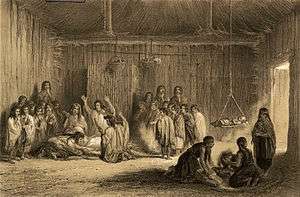
.jpg)
[ Note: the brief account of a machitun ceremony given to Plowman by Rolando Toro (see above), although first-hand, based on personal observations made by the author in Chiloé, reads more like an account relayed to him by another, although this may simply be a stylistic choice ].
Toro states that such ceremonies are always held at night and are believed to be effective in curing every type of infirmity, whether physical or mental, and likens them to "a witches' sabbath with curative ends". The night setting is readily understandable, given that Solanaceous narcotics like Latua dilate the pupils of the eye widely, as in low light intensities, a physiological effect which would make their use during the day unpleasantly dazzling for the consumer. The comparison to a witches' sabbath, however, has a literary flavour and conveys an impression of orgiastic behaviour somewhat at variance with the rather slow and sombre ceremony described, although certain parallels to conceptions of a night gathering of European witches are discernible.[28]
As in many types of New World, shamanic, curing rituals, not only the patient, but also the healer consumes "medicine": Toro describes the machi conducting the ceremony drinking doses of a Latua infusion at 20 -30 minute intervals in order to enter the altered state of consciousness in which healing is believed to be possible, before slowly beginning to sing and dance in a circle. The songs or chants consist of repetitions of the name of the plant intoxicant itself, rendered with variations of rhythm and tempo. Toro gives the following extract or sample:
Latué - latué - la - tué
La - la - la - tué
Tué
La - tué
La - a - a - a (slowly)
La - tué - la - tué - la - tué (fast)[28]
Toro describes the dance accompanying this rhythmic chanting as monotonous and characterised by a strange, inelegant rigidity reminiscent of catatonia [ see also Stereotypy ], the rhythms being marked by stamping of the feet and jerky movements of the head, while the arms are held out motionless "hanging like wings".[28]
This rhythmic, rather zombie-like dancing is kept up for some 4 -6 hours, interspersed with prayers which exhibit a syncretism between traditional Huilliche beliefs and Christianity - of which prayers Toro gives the following example:
Con un tizón ardiendo
[ trans: With a flaming torch ]
Cristo quema el mal
[ trans: Christ burns the evil ]
De vientro de (...)
[ trans: From the belly of ( here the name of the patient ) ][28]
The physical aspect of the treatment consists of three actions believed to cast out the demons of disease from the patient's body: first he or she is slapped with the malodorous branches of another poisonous, Solanaceous shrub Cestrum parqui, known locally by the name palqui ; secondly he/she is made to drink an emetic potion [ingredients unspecified] and thirdly his/her face is covered with the skin stripped from the genitals ( scrotum?) of a goat.[28] While the second treatment is obviously designed to induce vomiting, the other two also seem calculated to have the same effect. The inference is that the demons thought to be responsible for the patient's disease are believed to be living in his / her abdomen or, more specifically, stomach. Apropos of Toro's comparison of the Latua ceremony with a witches' sabbath, the token presence of goat genitalia recalls the traditional goat form[29] and prominent genitals[30] of the Devil, as featured in the testimony of early modern witch trials and in certain artists' depictions of the master of the sabbath.[29]
Latua use by machi in the 21st century
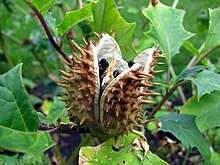
Bacigalupo (2007) notes in her recent study of the machi that Latua use has by no means died out among the Huilliche, although attitudes to the use of hallucinogens by machi appear to have become less positive than in the past.[13]
Some machi ingest palo de bruja (Latua pubiflora) or the seeds of the miyaya, or chamico, plant (Datura stramonium) in order to produce hallucinations, divine the future, exorcise evil spirits, and treat pain, mental illness, asthma and rheumatism. Machi who do not use hallucinogens are often critical of those who do, sometimes labelling them kalku (=[malign] witch), because it is assumed that they will use these plants to poison others.[13]
In this context, Bacigalupo goes on to quote one of her informants, Hortensia, a machi who does not use hallucinogenic plants because she maintains that only
...bad machi who do not trance on their own [i.e. cannot enter shamanic trance states without the aid of hallucinogens] use these herbs.[13]
Such a "purist" attitude and practice may be contrasted with Plowman's remarks concerning the general behaviour of machi in the 1970s and earlier :
The machi's training period is devoted to developing her psychic abilities through various methods: intense mental concentration and meditation, chanting, fasting, violent exercise in the form of whirling dances [compare Sufi whirling], auto-hypnosis and the constant use of narcotics. [Italics added.][6]
and again:
Hallucinogenic and narcotic plants play an important rôle in the life of the Mapuche shaman. These drugs are normally employed during the machitun ceremony and are administered to the young machi as part of her education.[6]
Chemistry
Latua pubiflora produces four Tropane alkaloids: scopolamine, hyoscyamine, apoatropine and 3α-cinnamoyloxitropane, giving it a chemistry and pharmacology similar to those of species belonging to the New World tribes Datureae and the Old World tribes Hyoscyameae and Mandragoreae which, like Latua, are placed in the nightshade subfamily Solanoideae, and possess similar anticholinergic properties, sharing also a similar history of use as entheogens in the practice of shamanism and witchcraft.[31][3]
Gallery
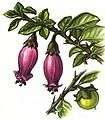 Reproduction of botanical illustration, showing flower and fruit.
Reproduction of botanical illustration, showing flower and fruit..jpg) Illustration from Curtis's Botanical Magazine.
Illustration from Curtis's Botanical Magazine. Mature specimen, Royal Botanic Garden Edinburgh Scotland.
Mature specimen, Royal Botanic Garden Edinburgh Scotland. Weeping / arching habit of lower branches of mature specimen flowering in Royal Botanic Garden Edinburgh.
Weeping / arching habit of lower branches of mature specimen flowering in Royal Botanic Garden Edinburgh.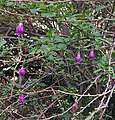 Pendent flowers among Spring shoots on arching branches.
Pendent flowers among Spring shoots on arching branches.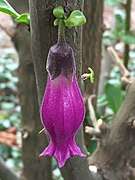 Mature specimen in Royal Botanic Garden Edinburgh exhibiting cauliflory.
Mature specimen in Royal Botanic Garden Edinburgh exhibiting cauliflory._Baillon_undehisced_anthers.jpg) Flash photo of flower, showing undehisced anthers.
Flash photo of flower, showing undehisced anthers._Baillon_stigma_and_unripe_stamens.jpg) Green stigma and unripe, cordate, purple anthers.
Green stigma and unripe, cordate, purple anthers. Commissure of contrasting magenta style and green, capitate stigma of exserted pistil.
Commissure of contrasting magenta style and green, capitate stigma of exserted pistil._Baillon_corolla_mouth.jpg) Corolla mouth, showing folding of interior of limb and ripe anthers.
Corolla mouth, showing folding of interior of limb and ripe anthers._Baillon_contrasting_old_and_new_flowers.jpg) Mature and senescent flowers, displaying exserted anthers.
Mature and senescent flowers, displaying exserted anthers. Magenta style, persisting after fall of corolla.
Magenta style, persisting after fall of corolla. Fallen corolla, positioned upright to show side view of tube.
Fallen corolla, positioned upright to show side view of tube. Base of a fallen corolla, showing fused, hairy bases of stamens - which confer structural strength.
Base of a fallen corolla, showing fused, hairy bases of stamens - which confer structural strength. Dissection of fallen corolla showing hairy stamen bases fused to interior.
Dissection of fallen corolla showing hairy stamen bases fused to interior. Single, insect and/or mollusc-damaged ripe fruit of mature specimen, Logan Botanic Garden.
Single, insect and/or mollusc-damaged ripe fruit of mature specimen, Logan Botanic Garden.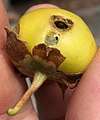 Same fruit (after having fallen) held up to show pubescent pedicel and broad calyx lobes.
Same fruit (after having fallen) held up to show pubescent pedicel and broad calyx lobes. Same fruit, positioned pedicel-uppermost to show distinctive broad, spreading calyx lobes, turning brown with age.
Same fruit, positioned pedicel-uppermost to show distinctive broad, spreading calyx lobes, turning brown with age. Spring shoots, emerging from older, arching growth of mature specimen, Royal Botanic Garden Edinburgh.
Spring shoots, emerging from older, arching growth of mature specimen, Royal Botanic Garden Edinburgh. Young spines borne in leaf axils of vigorous Spring shoot with densely pubescent stem.
Young spines borne in leaf axils of vigorous Spring shoot with densely pubescent stem. Summer foliage of mature specimen, Royal Botanic Garden Edinburgh.
Summer foliage of mature specimen, Royal Botanic Garden Edinburgh. Young, grey-green bark with buff striations of trunk of young specimen in Royal Botanic Garden Edinburgh.
Young, grey-green bark with buff striations of trunk of young specimen in Royal Botanic Garden Edinburgh. Semi-mature bark displaying development of characteristic corky fissures.
Semi-mature bark displaying development of characteristic corky fissures. Mature bark, clad completely in corky tissue with reticulate pattern. Base of main trunk of mature specimen Royal Botanic Garden Edinburgh.
Mature bark, clad completely in corky tissue with reticulate pattern. Base of main trunk of mature specimen Royal Botanic Garden Edinburgh. Healthy main trunk of mature specimen, Royal Botanic Garden Edinburgh.
Healthy main trunk of mature specimen, Royal Botanic Garden Edinburgh._Baillon_mature_trunk.jpg) Moribund main trunk of mature specimen at former site of nursery, Herefordshire, U.K.
Moribund main trunk of mature specimen at former site of nursery, Herefordshire, U.K.
References
- "Latua". Germplasm Resources Information Network (GRIN). Agricultural Research Service (ARS), United States Department of Agriculture (USDA). Retrieved 21 January 2018.
- Armando T. Hunziker: The Genera of Solanaceae. A.R.G. Gantner Verlag K.G., Ruggell, Liechtenstein 2001. ISBN 3-904144-77-4
- Schultes, Richard Evans; Hofmann, Albert (1979). The Botany and Chemistry of Hallucinogens (2nd ed.). Springfield Illinois: Charles C. Thomas.
- Emboden, William, Narcotic Plants – Hallucinogens, stimulants, inebriants, and hypnotics, their origins and uses 2nd edition, revised and enlarged, pub. Macmillan Publishing Co., Inc., New York 1979, ISBN 0-02-535480-9.
- August Grisebach, Rodolfo Amando Philippi Krumwiede, and Claude Gay (1854), Systematische Bemerkungen über die beiden ersten Pflanzensammlungen Philippi's und Lechler's im südlichen Chile und an der Maghellans-Strasse (Systematic remarks on the first two plant collections of Philippi and Lechler in southern Chile and the Straits of Magellan region – abbreviation: Syst. Bemerk.): pp. 40–41.
- Plowman, Timothy, Gyllenhaal, Lars Olof and Lindgren, Jan Erik Latua pubiflora magic plant from southern Chile Botanical Museum Leaflets Harvard University Vol. 23, No. 2, Cambridge, Massachusetts, November 12, 1971
- Febrés, P.A., 1764, Arte de la Lengua General del Reyno de Chile (publisher not given) Lima, page 528.
- Lenz, R., 1904, Diccionario Etimolójico de las Voces Chilenas Derivadas de Lenguas Indígenas Americanas pub. Imprenta Cervantes, Santiago. page 425.
- Valenzuela, P.A. 1917 "Glosario Etimológico de Nombres de Hombres, Animales, Plantas, Ríos y Lugares y de Vocablos Incorporados en el Lenguaje Vulgar Aborígenes de Chile" Revista Chilena de Historia y Geographía, Vol. 22, page 290.
- Rätsch, Christian (1998). The Encyclopedia of Psychoactive Plants: Ethnopharmacology and its Applications. Rochester: Park Street Press: page 219.
- Latcham, R.E. 1924 La Organización Social y las Creencias Religiosas de los Antiguos Araucanos Publicaciones del Museo de Etnologia y Antropologia Vol. III.
- Faron, L.C.,1964 'Shamanism and Sorcery among the Mapuche of Chile' in R.A. Manners ed. Process and Pattern in Culture pub. Aldine Publishing Company, Chicago.
- Bacigalupo, Ana (2007). Shamans of the Foye Tree. Austin: University of Texas Press.
- Scala, A.C. 1920, Contribución al Estudio Histológico de la Flora Chilena IV: Latua pubiflora ( Griseb. ) Phil. in Revista Chilena de Historia Natural Vol. XXIV (4). pp. 73–78.
- Gunckel, L.H., Contribución al Conocimiento de la Flora Valdiviana VI. Revista de la Associación Chilena de Química y Farmacia Vol I (5), pp. 2–3.
- Murillo, A., 1899 Plantes Medicinales du Chile. Exposition Universelle de Paris, Section Chilenne pp. 152–155.
- Wettstein R. v. 1891 Solanaceae in Engler A. and Prantl K., Die Natürlichen Pflanzenfamilien, Teil IV, abteilung 3a, pp. 12 & 15.
- "Los Lagos Region". Government of Chile Foreign Investment Committee. Retrieved 13 March 2010.
- [Personal observation, substantiated by dates upon which particular photos used on this page taken].
- Dragendorff, G., 1898 Die Heilpflanzen der verschiedenen Völker und Zeiten. Ihre Anwendung, wesentlichen Bestandtheile und Geschichte (trans. "Medicinal plants of various peoples and times. Their application, active principles and history"), pub. Verlag von Ferdinand Enke, Stuttgart, page 589.
- Reiche, K., 1901 Los Productos Vejetales Indíjenas de Chile, pub. Imprenta Cervantes, Santiago.
- Lewin, L., 1929 Gifte und Vergiftungen. Lehrbuch der Toxikologie (trans. "Poisons and Poisoning: Textbook of Toxicology") pub. Verlag von Georg Stilke, Berlin. Reprinted by Haug, Heidelberg 1992, ISBN 3-7760-1286-2. page 808.
- Serna, Father Leandro of Río Frío, Llanquihue Province, Chile, 1969 - personal communication to authors of Harvard Botanical Museum Leaflet on Latua: Plowman, Gyllenhaal and Lindgren.
- Mariani, Ramírez C., 1965 Temas de Hipnosis pub. Editorial Andrés Bello, Biblioteca de Estudios Médicos, Santiago. page 336.
- Sparre, B. ( Curator of Museum of Natural History, Stockholm in early 1950s ) 1970. Letter to the authors of the Harvard Botanical Museum Leaflet on Latua: Plowman, Gyllenhaal and Lindgren.
- Philippi, R.A., 1861, Descripción de un Nuevo Jénero de Plantas de la familia de las Solanáceas Anales de la Universidad de Chile Vol. XVIII (3) pp. 309–311.
- Pomar, L. 1901 An Account of the Fishing Industry in Chile, Pan American Exposition Publication IV, pub. Imprenta Moderna, Santiago. Page 33.
- Toro, R. 1969: personal communication to Dr. Timothy Plowman in Santiago de Chile.
- Grillot de Givry, Émile-Jules, Musée des sorciers, mages et alchimistes, Imp. De Compiègne, Librairie de France, 1929, 1st edition, English translation by J. Courtenay Locke published by Causeway Books New York 1973 under the title Illustrated Anthology of Sorcery, Magic and Alchemy ISBN 0-88356-018-6. Book 1 Sorcerers Chapter VI The Sabbath (pps. 72-89).
- Wilby, Emma, 2010 The Visions of Isobel Gowdie : Magic, Witchcraft and Dark Shamanism in Seventeenth-Century Scotland pub. Sussex Academic Press, Hardcover ISBN 978-1-84519-179-5 page 212.
- Muñoz, O.; Casale, J. F. (2003). "Tropane Alkaloids from Latua pubiflora" (PDF). Zeitschrift für Naturforschung C. 58c (9–10): 626–628. doi:10.1515/znc-2003-9-1003. ISSN 0939-5075. PMID 14577619.